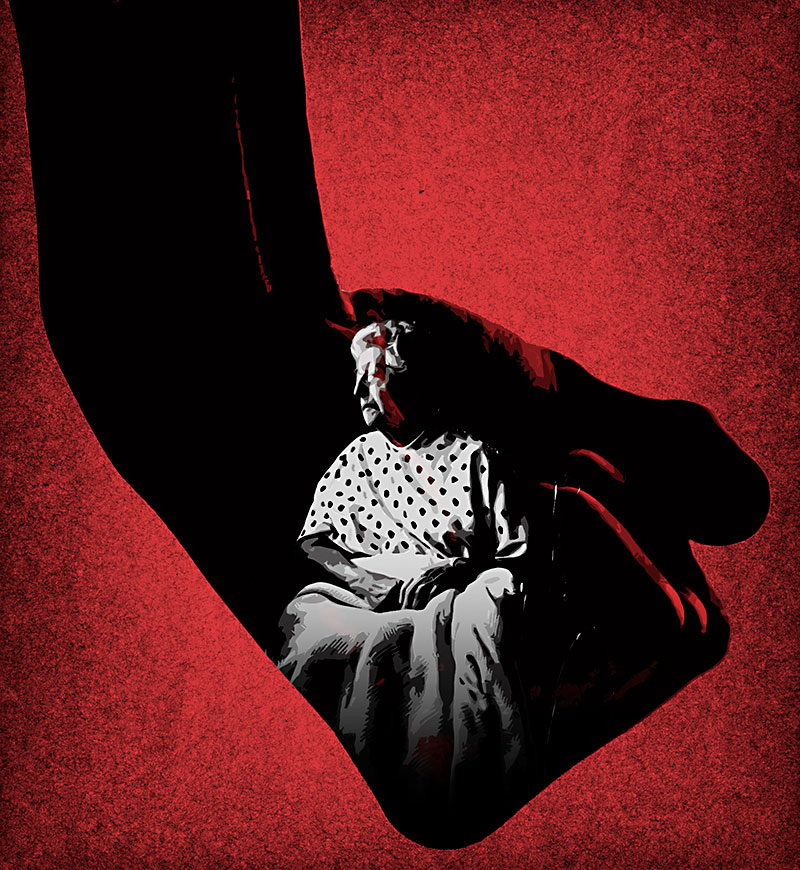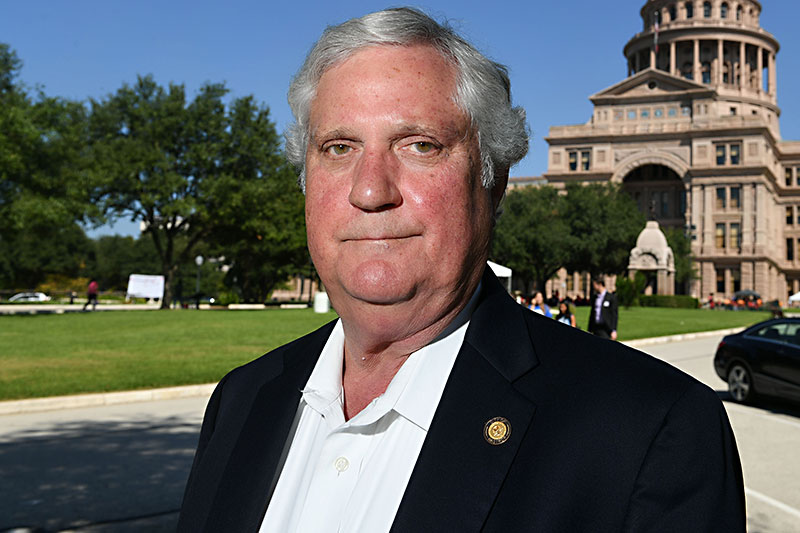25% of the state's 1,200 long-term care centers have been cited for serious standard deficiencies
In The News:
By Nina Hernandez and Annamarya Scaccia, Fri., Oct. 20, 2017
Back in July, news broke out of North Austin that a 90-year-old resident of a nursing home had accused one of its employees of abuse. The woman said that as punishment for wetting the bed, the employee would flip the disabled woman over and strike her repeatedly on her backside.
This was hardly an isolated incident. Just months before, the Texas Department of Aging and Disability Services told KXAN that it was investigating a gruesome video, recorded at another Austin nursing home, that depicted a patient, whose hand is covered with feces, getting her nose tickled with a feather being held by a nurse’s aide. The video was uploaded onto Snapchat, and showed the gleeful aide watching as the woman reached to scratch her face with her feces-covered hand.
Though Texas maintains a host of laws that pertain to nursing home care, the state has an equally long history of trouble doing right by its elderly citizens. In January, the AARP released a blistering report titled “Intolerable Care,” which paints DADS as a toothless regulatory system that allows bad actors to get away with hurting clients. “Texas nursing home quality is shamefully poor,” it reads. “As a result of this intolerable care, many residents of Texas nursing homes face unnecessary health and safety risks.”
Limits of the System
For at least one former nurse’s aide, this summer’s news did not come as any surprise. Ty, who requested we only report her first name, fearing professional repercussions, had no idea what awaited her at the Windsor Nursing and Rehabilitation Center of Duval – the long-term care facility now under investigation for the Snapchat video – when she applied to work there last June. The center, located at 5301 W. Duval Rd. in Northwest Austin, was offering a class that would allow Ty to become a certified nursing assistant – a foothold into the medical industry, which she hoped could support her and her child.
But the Windsor program “wasn’t much of a class.” Ty said she and her classmates did some book work, but “for the most part they had us out on the floor working.” She describes the program as a working internship where students couldn’t physically handle any of the patients because they were trainees. But that standard went out the window, she said, when she was put on a floor with no other employees.
“I didn’t have a choice,” Ty recalled. “I had to change people. I had to help people. I had to bathe people. I had to do everything, because there was nobody else there to do it. So that was one thing that kind of threw up red flags for me. But I was like, ‘Hey, if this is what I’ve got to do to get this certification, then that’s what I’m going to do.'”
Ty continued to work at Windsor until last October, and through those five months witnessed a number of incidents that caused her alarm. In one case, a client accused one of her co-workers of abuse. Ty said she navigated through a charge nurse, the director of nursing, and others within her chain of command to report the issue, but “nothing happened.” In another, she witnessed a woman whose soiled briefs were simply covered up with a fresh pair. “Not only is this woman soaked, but she is soaked all the way through all of her legs,” she recounted telling a co-worker. “And she has on two briefs, both of which are oversized.
“Neither one of those briefs were the ones she was supposed to have on. But she was soaked through both briefs. When was the last time somebody changed her?”
Abuse In Our Backyard
The severe abuse at Windsor seems to be compounded by severe neglect. Ty said that nurses often ignored or dismissed her concerns about patients’ health. During one shift, she noticed that a client had red splotches and busted blisters on and around her chest, and thought she may have shingles. Ty alerted the nurse, who said she would check on the resident. But instead, she continued to play on her phone and gossip with her colleagues, who should have been on the floor. The nurse didn’t visit the resident until later on in the day. It turns out she did have shingles.
Nurses also tried to cover up allegations of maltreatment. Ty said the son of one resident filed a complaint against the nurses, claiming they repeatedly abused his father. The nurse in that case tried to twist the father’s words so that the term “abuse” would not be used to describe the incident – instead trying to coax the father into saying that they were “being too rough,” said Ty, who was in the room when the incident was reported.
Ty was dismissed from her job after getting into an argument with one of the head nurses. She said she declined to follow the nurse’s command to move one patient from her bed to a chair. That patient, who had bruises all over her body, complained to Ty that she was in pain after a worker twisted her back during a treatment session. The patient didn’t want to leave her bed, nor did she want pain medication. When Ty told the nurse, she dismissed her concern and sternly told her to take the woman out of the bed. Ty refused, standing up for her patient’s wishes.
“She was crying, literally sobbing [about] how bad she was hurting,” she recounted. It was the incident “that broke the camel’s back.” The nurse became angry and “blew up.” She and Ty went into the hallway, where they had an argument. The nurse found another worker to put the resident into a chair, where she eventually sat all day. The nurse had Ty taken off the schedule, and she was later suspended. Ty went back to work after a couple of weeks, but was let go under the pretense that she first had to pass her certified nursing assistant certification.
Ty reported the abuse she witnessed to corporate management, but said leadership never responded directly to her complaints. Instead, they gave her the runaround, forcing her to go back and forth between corporate and the center’s administration. “It doesn’t seem like they’re doing anything,” she said.
In March, state and federal officials investigated six months’ worth of complaints lodged against Windsor Nursing and Rehabilitation Center. The 206-bed facility was found in violation of four federal and four state health standards, according to the Texas Department of Health and Human Services. (Texas facilities on average incur only three.)
The violations align with Ty’s allegations. According to state and federal records, Windsor had failed to protect residents from abuse, maltreatment, and isolation, and neglected to provide compassionate and competent care. The North Austin nursing home also fell short protecting residents’ privacy and confidentiality. These health infractions were allegedly corrected this year, on April 17. The Centers for Medicare and Medicaid Services, which manages the Nursing Home Compare rating system, ranks Windsor below average for quality of resident care, as well as for health safety. A CMS health inspection conducted in July cited the facility with nine deficiencies – four of which deal with mistreatment.
“There are explicit rights for residents, and these kinds of violations get directly at those rights,” said Amanda Fredriksen, associate state director of advocacy for AARP Texas. “Like the right to be free of abuse and exploitation, [or] the right to privacy.”
Neither Windsor nor its management company, Regency Integrated Health Services, responded to multiple requests for comment.
Intolerable Care
The Irving-area nursing home Darla Culpepper took her mother to seemed like an excellent facility. A high turnover rate among the administrative staff and nursing directors did eventually lead to a discomforting lack of continuity in care, but Culpepper said she never thought her mother was in danger. Then, in December, Annie Lynette Allen suffered a stroke.
That was one of the things her mother’s doctor had told her she shouldn’t worry about. As long as Allen’s caretakers made sure to administer the anti-stroke medication according to doctor’s orders, she would remain stroke-free. It wasn’t until after her mother had her stroke that she checked again with Allen’s doctor, and found out that the medication had been discontinued without her knowledge. The family filed a report with the Irving police, and DADS eventually cited the home on Allen’s behalf. Culpepper said it took a substantial effort.
“I can’t remember if it was the third or fourth time that I called back, and I said, ‘I’m filing a new report, and I just want to tell you this: I’m not going away,'” said Culpepper. “‘Unless I die tomorrow, I’m not going away until you do something.'”
Statistics show that throughout the country, health-standard violations found in nursing homes are on the decline. But in Texas the number is spiking. According to The Dallas Morning News, cited deficiencies in Texas facilities rose by 20% between 2010 and 2014; severe infractions increased by 3% over that time. Over that same period, however, severe violations at nursing homes across the country declined by 16%.
Incidents of abuse, like what happened at Windsor, are not a new phenomenon in Texas. It’s part of a larger pattern of poor care that lands the state at the bottom of quality lists. In 2014, Families for Better Care, a nonprofit advocating for better nursing home care, ranked the state 51st out of 51 (including Washington, D.C.), and gave it an “F” grade. Texas stayed put the following year, according to the Houston Chronicle. And, as recently as August, found itself in third place for worst nursing home care – right behind New Mexico and Kentucky, according to ProPublica.
“There are very good nursing homes in Texas,” said Bastrop attorney David Bragg, a civil litigation attorney who specializes in nursing home and assisted living center abuse and neglect. “I’ve seen them firsthand; even way back in the dark days they were still there.
“A nursing home, even though it is excellent, can all of a sudden have a horrible night when two staff members call in sick, and suddenly they’re short of staff. And now they’ve got the same patient requirements but fewer people to do it with. And when that happens, even the really good nursing homes can have a bad night – a bad experience.”
Bragg has spent decades watchdogging the state’s nursing home industry. In the Seventies, when he headed the Attorney General’s Consumer Protection Division, Bragg was directed by Attorney General John Hill to start a task force to investigate reports of nursing home abuse in the state.
At the time, the nursing home lobby was one of the more powerful lobbying arms within the state. Bragg’s 20-member task force, made up of attorneys, a social worker, and other investigators, set about its task by going from nursing home to nursing home. Bragg recalls bringing a toy blow gun from his house into the office: He would shoot a dart from the gun at a map of the state that he’d positioned on a wall. Wherever the dart landed, the group would conduct surprise inspections of the facilities in that area.
“After the task force had done its work, you could see some improvement in this sense: If bad things were continuing to happen, they were better concealed and not so obvious,” he said. “We know we were able to stop some bad things from happening, but then it ended. Over time, the industry … went to its prior ways.”
Texas: A Good Place To Grow Old?
Of the more than 1,200 long-term care centers in Texas, 306 have been cited with serious standard deficiencies, according to ProPublica. The AARP’s “Intolerable Care” report indicates that inspectors identified 766 severe violations from state fiscal year 2015 that either involved immediate jeopardy of – or actual harm to – a resident. That’s only 41 fewer than investigators cited the year before.
More damning: In 2015, inspectors cited Texas nursing home facilities for 17,466 violations over a 12-month period, according to AARP’s report. Yet DADS took only 40 enforcement actions. In 2014, there were nearly 18,900 infractions and only 39 sanctions. Worst of all, in 2013, state authorities took action in only 11 – or less than 1% – of the nearly 19,000 violations cited in nursing homes. “We need a regulatory structure that holds facilities accountable when those kinds of things happen,” said Fredriksen. “They should be fixing those problems. They shouldn’t be tolerated when it escalates.”
Many of the cited nursing homes are repeat offenders. Yet the AARP notes that Texas officials routinely fail to impose significant penalties on these facilities. More than 320 long-term care centers accounted for 94% of all serious violations in fiscal years 2014 and 2015. The state only collected fines from 22 of those facilities.
But it’s not only the state’s lack of action that allows nursing home abuse to continue unabated. According to Fredriksen, it’s not uncommon for officials to categorize infractions in a class that diminishes the severity of the situation. Take, for example, this year’s Snapchat case at Windsor: State inspectors classified that incident as a Level E violation, which means officials found a pattern of “potential” for actual harm, but that no actual harm occurred. “To be clear, we would all think this is a pretty serious violation,” noted Fredriksen. “But Level E isn’t exactly a serious violation.”
Under the state’s “right to correct” law, a Level E infraction means Windsor would have the opportunity to address and rectify the alleged abuse without facing any financial sanction. ProPublica’s Nursing Home Inspect database indicates that most infractions found at Texas nursing home facilities are classified as Level E or F. (Level F citations recognize a widespread potential for actual harm, with no actual harm occurring.)
But leaving facilities to take corrective action doesn’t guarantee abusive behavior will stop. After all, Windsor is one of the few hundred nursing homes in Texas that have been cited multiple times for mistreatment.
“What we see is there are a significant number of facilities that have repeated violations,” Fredriksen said. “Over time, we see those violations escalate.”
A spokesperson for Texas Health and Human Services, which now oversees the functions of DADS, said the AARP report fails to consider “the federal penalties we’ve pursued and recommended to CMS.
“Since most nursing facility surveys and investigations are federally funded, HHSC recommends federal civil money penalties in the vast majority of cases involving a serious violation. This is the chief reason for the low number of state administrative penalties issued.”
Nowhere to Turn … Not Even the Courts
Victims and their loved ones are not only failed by a fractured regulatory system. Legislation governing tort cases has severely restricted their path to legal recourse.
In 2003, Texas lawmakers limited the payout in a tort liability case to $250,000. They had enacted the “tort reform” law in an effort to curb the number of lawsuits lodged against physicians in the state. By 2011, medical malpractice claims dropped by nearly two-thirds, to 450 cases, according to state data; the average amount of damages awarded also fell significantly, by 22%.
The “tort reform” law achieved what lawmakers hoped: It restrained claims, which allowed malpractice insurance premiums to drop, thus attracting more doctors to the state. But the legislation has also made it far more difficult for family members to hold offending doctors and nurses accountable for negligence and abuse. Medical malpractice lawsuits are now costly to pursue, said Marian Rosen, a partner at the Houston-based law firm Rosen & Spears, one of the few groups still taking on these cases in Texas. “It really impacts the ability of a plaintiff to find someone who will handle these cases,” she said.
Prior to reform, the preponderance of evidence standard was lower, and only one expert was required to testify on behalf of the plaintiff. Now, lawyers must hire at least two medical experts to review records, which can cost tens of thousands of dollars, before the case can move ahead. Attorneys must also file detailed and technical expert reports in a nursing home case, and have no allowance to add attorney fees and additional expenses to awarded damages.
Often, because family members bringing these claims don’t have the money to foot that bill, law firms will turn them away because there’s no payout at the end, she added. Said Rosen: “The cap alone makes it financially difficult, if not impossible, for many lawyers to handle these cases.”
Reforming a “Shamefully Poor” Industry
Advocates have long pressed state lawmakers to do something – anything – to end the epidemic of abuse and neglect in nursing homes. They say facilities have been able to perpetuate maltreatment against their residents for so long because of lax policy and poor enforcement by regulatory agencies.
It seems the Texas Legislature has finally listened. In June, a bipartisan coalition of state lawmakers passed House Bill 2025, in an effort to crack down on offending nursing homes that routinely dodge punishment. The bill, which went into effect in September, would close that “right to correct” loophole, permitting the state to impose hefty fines on repeat offenders where before those facilities could correct any violations without penalty. For nursing homes afforded a “right to correct,” the amount of time to submit proof of corrective action has been shortened to 45 days.
The law, Fredriksen said, is “a good starting point” for reforming what the AARP has called a “shamefully poor” industry. HB 2025, she said, is “beginning to give the agency the tools it needs to fully regulate the nursing home license, which is what the state has authority over.”
Providers do not seem to be thrilled about the law. In July, Phillip Hopkins, president of long-term care facilities operator TAG Management Services, told the Texas Tribune that tighter regulations will only hinder the ability of his business to provide high-quality care. But, as the AARP’s report showed, nursing homes were empowered to repeat violations because Texas law had given them the power to “fix” those violations. And though, as the Sunset Advisory Commission wrote in its 2015 report, DADS could have acted “more aggressively” in its role as a regulator, state officials were also bound by those ineffective policies HB 2025 seeks to reform. HHSC spokesperson Christine Mann said of the law: “As always, we must continue to take a number of factors into consideration when imposing penalties, and this includes a facility’s history of repeated and ongoing violations and the nature and seriousness of the violations.”
Still, even if it’s a good start, HB 2025 doesn’t tackle all of the issues that plague Texas’ nursing home industry. Although the law narrows the type of infractions eligible for a “right to correct,” it doesn’t eliminate that option for Level E or F because those categories fall outside of what’s considered substandard quality of care. Nor does the legislation mandate an escalation or increase in sanctions for repeat offenders that could serve as an incentive to curb bad behavior. “For fines to be effective, they need to be more than simply the cost of doing business,” said Fredriksen.
HB 2025 also fails to address existing dichotomies in oversight. In most states, the Centers for Medicare and Medicaid Services and state agencies assess violations and sanctions separately. That means that even when infractions are similar, a nursing home cited for a deficiency would have to pay two fines.
But Texas is one of a handful of states that “essentially ceded control to the federal government,” Fredriksen said. If a facility is cited with the same violation by state and federal actors, it would only pay one fine and Texas “essentially defers to the federal government for how that gets done.” State law prohibits the agency from assessing a state penalty if federal penalties are used as an enforcement tool for the same violation.
“The state should have the authority to enforce its state regulations,” she said. “We shouldn’t be deferring to the federal government for enforcement of those regulations if, in fact, they overlap.
“It’s a separate process. It should have a separate set of enforcement.”
Making Real Change
In the Nineties, Bragg got tapped again by another state official – this time Gov. Ann Richards – to delve back into the nursing home industry and again, as a citizen trustee, root out its bad actors. The investigation resulted in nearly 20 facilities getting taken over by trustees.
“There hasn’t been a trustee appointed in five, six, seven – in years,” Bragg lamented when we spoke with him last month. “All the tools are there. The enforcement mechanisms are there. I suspect the people are there. The difference is no one is seeing things through what I would call ‘angry eyes,’ where you have to wholly reject the notion that people should be allowed to rot in nursing homes; that they should be allowed to sit there; that they should not be tended to professionally by skilled workers. And I don’t sense that.”
Years ago, when Bragg was actively investigating nursing homes, he suggested an oral history program that would tell the stories of people in the facilities. He still recalls one woman he met through that work who came to Texas by covered wagon. But no one at the state’s Department of Education would help him establish the program. “It occurred to me that if people in the community saw people in long-term care facilities as their neighbors, as their friends, got to know them, then there wouldn’t be this kind of neglect any more than we would withstand it in the child of a person who lives next door,” he said. “But it’s not a societal value. In that sense, we warehouse people and kind of get them out of sight and therefore out of mind. And I think that’s what makes it relatively easy for the bad players in the industry to slip back into bad practices.”
That’s an all too common scenario for long-term care facilities in Texas. Advocates say a weak regulatory system and lack of awareness have allowed abuse to persist in nursing homes, even those that have incurred fines for infractions.
Ty doesn’t want to see that happen at Windsor, even though she feels powerless. The former employee eventually completed her nurse’s aide certification at another location, and moved away from Austin. But she remained in contact, in order to ensure that the Windsor story didn’t disappear from the public consciousness, like so many cases do.
The state “came in and did their investigation, and they called me later and said that they couldn’t find anything there that was wrong,” Ty said. “And I find that very difficult to believe, only because there are so many clients there that actually have legitimate complaints. And that’s kind of what I was up against. I figure [the state] will come back with what they came back with, as far as not being able to find anything that’s wrong. I just let it be. They don’t want anything to change.
“Who am I?” she added. “I can’t make them change.”
Personal Note from NHAA – Advocates: NHAA shares with all the families of loved ones who are confined to nursing homes the pain and anguish of putting them in the care of someone else. We expect our loved ones to be treated with dignity and honor in the homes we place them. We cannot emphasize enough to family members of nursing home residents; frequent visits are essential to our loved ones’ well-being and safety. This nursing home and many others across the country are cited for abuse and neglect.
You can make a difference. If you have a loved one living in this nursing home or any other nursing home where you suspect any form of abuse or neglect, contact us immediately.
We have helped many already and we can help you and your loved one as well by filing a state complaint, hiring a specialized nursing home attorney or helping you find a more suitable location for your loved one.
Contact us through our CONTACT FORM located on our website here below or on the sidebar or call our toll free hot line number: 1-800-645-5262.
You can make a difference even if your loved one has already passed away.
Your Experience Matters
...and we want to hear it.
NHAA is here to assist families, residents, and the community by sounding the alarm on issues like those found above. This nursing home and many others across the country are cited for abuse and neglect.
If you have or had a loved one living in this nursing home or any other nursing home where you suspect any form of abuse or neglect, contact us immediately.
We have helped many already and we can help you and your loved one as well by filing a state complaint, hiring a specialized nursing home attorney or helping you find a more suitable location for your loved one.
You can make a difference, even if your loved one has already passed away.
Please give us a call at 1-800-645-5262 or fill out our form detailing your experience.
Personal Note from NHA-Advocates
NHAA shares with all the families of loved ones who are confined to nursing homes the pain and anguish of putting them in the care of someone else. We expect our loved ones to be treated with dignity and honor in the homes we place them. We cannot emphasize enough to family members of nursing home residents; frequent visits are essential to our loved ones’ well-being and safety.
If you are struggling and upset, click here to understand your options, or contact us through our contact form or call our toll free hot line number: 1-800-645-5262.










